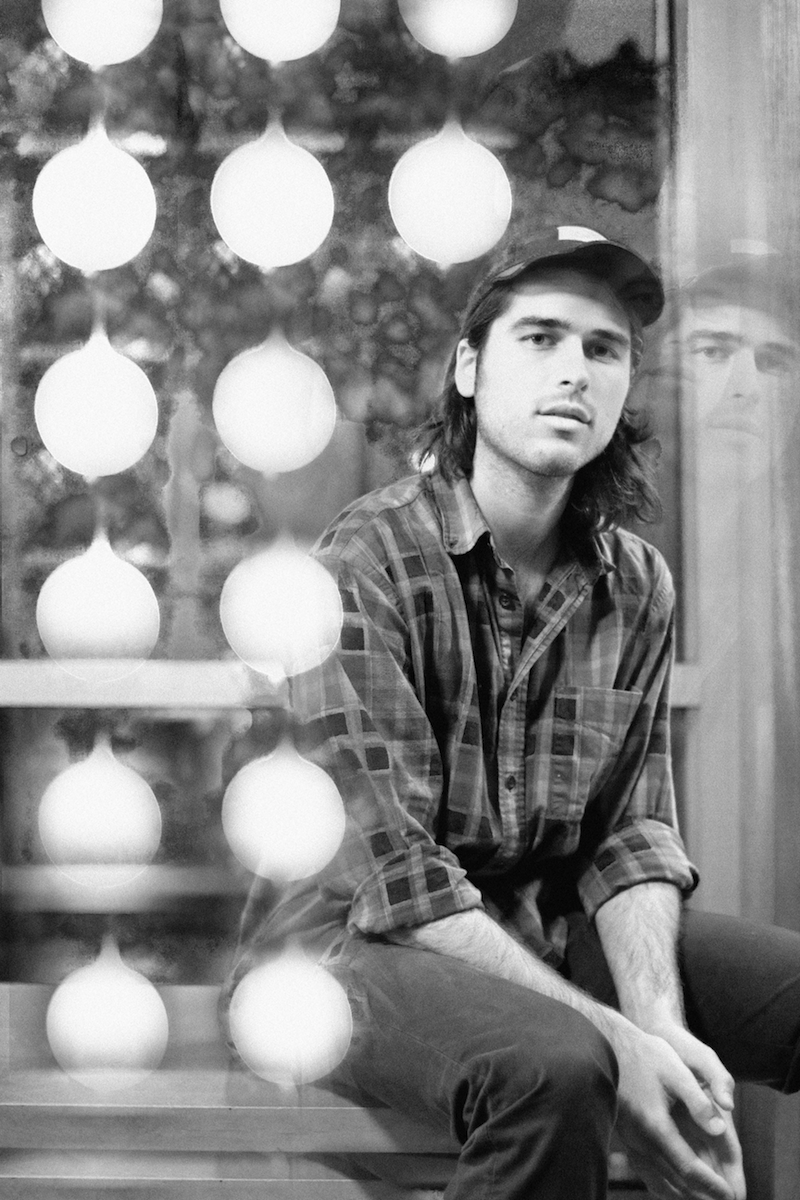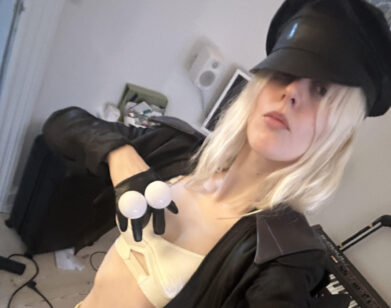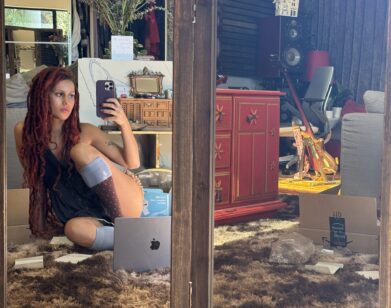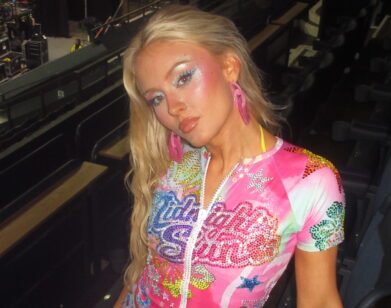Trash to Treasure: Ben Lear’s ‘Lillian’

BEN LEAR. PHOTO BY BENJAMIN STELLY
Ben Lear’s multimedia performance tonight at (Le) Poisson Rouge of his album, Lillian: A Folk Opera, has been a long time in the making. Lear, who graduated from NYU with a degree in music composition, started work on Lillian two and a half years ago, in spring 2009; it’s been staged in several iterations since then, but tonight’s performance is set to be the most complete—and ambitious—one yet.
While the “opera” label for contemporary indie and rock albums often just boils down to pretension on part of the musician, Ben Lear fully earns it with Lillian, which tells a complete, poignant story: his protagonist, watching his sleeping lover, fears that she’ll drift away from him, joining all the things he’s lost in his life, which he thinks have ended up floating in the Great Pacific Garbage Patch. Desperate, he sets off on a sea voyage to the trash gyre, where he plans to reclaim what he’s lost—but what he finds along the way, and once he reaches the patch, trigger self-discoveries beyond what he anticipated.
After releasing Lillian, Lear has become something of an anti-pollution poster boy: he performed at the Plastic Pollution Coalition’s TEDx event last fall; was invited on a three-week sailing expedition from Chile to Easter Island, collecting plastic samples from the previously unstudied South Pacific Gyre; and even appeared on—of all places—Fox News. But Lear’s most recent project is perhaps the best marriage of his interests: over a week this summer in Vermont, he undertook the Lillian Bottle Project, a collaboration with light sculptors Mah Su Sim and Lisa Foo. Lear and some helpful friends turned 3,000 plastic bottles into LED light sculptures, which will take the stage with him (and an orchestra, gospel choir, and projected animation) tonight at LPR.
ALEXANDRIA SYMONDS: How did the idea for Lillian come about?
BEN LEAR: The initial idea wasn’t so much the story itself; it was the form. I got really excited by the idea of doing something that was very much just an album—and the type of music that I love and I love to make, not changing that at all—but putting it together in such a way where I could augment certain things theatrically, for the live show. I never get tired of seeing bands play—that’s what I love to do, at the end of the day. But there’s such an opportunity, especially now, where different technologies allowing for multimedia experiences are getting so much more available. And I live in the city, where I have so many friends in different artistic mediums who want to do projects together, I thought there was an opportunity that could be had for a band to just do something really different and bigger and wilder, live. And then I realized [the way] that would have to happen was I would tell a story, and do something along the lines of an opera.
The only thing scary about calling it a “folk opera” or whatever else is just instant connotations, when in my mind, I really haven’t seen anything exactly like what Lillian wants to be. So the first idea was, “Where do I write most of music?” And it’s alone, at night, in my bedroom. I thought it would be cool to take that setting and put that on the stage and have my band kind of spread out in my bedroom as figments of my imagination. Initially, I thought I was just going to write an album’s worth of songs where I would be kind of dealing with issues and working through things alone in my room. And that was the idea, just to create a really beautiful, elaborate set of a New York apartment. And then, around the time I was beginning to write that, I found out about what was then known as the Garbage Patch, and now, I guess is called the North Pacific Gyre—and all these gyres, these huge vortexes of plastic swirling around in every one of our five oceans, and there’s 11 smaller ones in various seas and waterways and stuff. That just instantly gripped me, because I was working with this idea of: what if there was this place that had everything you’ve ever lost, and what if you could go there, and what would it look like, and what would it feel like to sort through those things, like a flea market for memories and old computer files and keys and all that stuff.
SYMONDS: I know that you’ve called the album’s protagonist a character, rather than saying that it’s you, necessarily.
LEAR: Yeah.
SYMONDS: I’m curious how you worked out your relationship to him—and how much work you did to create the character before you started writing the songs?
LEAR: Well, I knew instantly that it pretty much was me. There’s really nothing about that character, except from the fact that girls he’s dealing with and the story itself is fictionalized, but very, very close to what is real. Like Lillian, for example, is an amalgamation of girls that I’ve known in my life, and relationship experiences that I’ve had. I tried coming up with a name for the character, and I realized I couldn’t do that because it didn’t feel honest, because it is me. So instead, I just didn’t really name him, and I just referred to him as Diver, because that’s kind of what he is. He becomes, in my mind, a bit of an archetype—not like a superhero, but the protagonist archetype of the guy that goes on the mission to find the girl but really doesn’t know what he’s talking about.
Because the whole idea behind the story is he convinces himself that these outside forces, like the waves and currents of the ocean, have pulled everything away from his life, including Lillian, this girl that he cares about. And he’s totally oblivious to the fact that, in reality, he pushed her away and had been doing so for a long time, just by being completely unavailable, emotionally, for reasons that he figures out along the way. And then he realizes once he gets to this garbage patch that it’s nothing that he thought it was, rather it’s literally just pieces of floating plastic that are irrelevant to him.
SYMONDS: If you could go visit the patch as the diver imagines at the beginning of the album, and you were allowed to bring one thing back, what would it be?
LEAR: Oh, man. I think at the end of the day, it’s the intangibles that are the most interesting. And I think this is probably common for most people, but what I would want to bring back is some sense of how I looked at the world before I had any concept of knowing it.
SYMONDS: Yeah.
LEAR: Last night, actually, I was going to bed, I just had this memory—I used to sit in my room when I was a kid and talk to myself for hours, and be really ridiculous and yell at my computer and talk in voices and do really strange things with my body. Just like, basically get taken over by silliness. And that’s completely, 100% gone from my life now. I’d like to find that.
SYMONDS: And once you become aware of wanting to go back and find that, then it’s not organic anymore, which is a shame.
LEAR: Oh, totally. I realized also last night, randomly, someone said something about permanence in context of the show, and then I realized that’s also another theme – not necessarily something I’m looking for, but the idea of what’s permanent and what’s not? Do we hold onto all of our memories and have a problem of accessing them, or are they gone, for real? The plastic floating around in the ocean is permanent, and that’s something that no one ever thinks about when they toss a bottle in the recycling and think they’re doing a good thing. It will never go away, it will stay here in some form. And this character’s fear, to some degree, of permanence, in his love life, which is one of the reasons he kind of unknowingly pushed this person away and had been doing so his whole life. That’s just kind of a side thought.
SYMONDS: It seems like you’ve become tapped as this expert on these gyres. You went and did a three-week sailing expedition, taking samples, and you went on Fox News, and now you’re the guy that people go to talk about the gyres. Did you expect that to happen?
LEAR: I definitely don’t consider myself an expert—I consider myself a totally normal person that just has a really heightened interest level in the topic. I think that has led me not only to use it in my work, but to get to know some of the people that I do consider experts and spend a lot of time with them, which has been invaluable to me. Like Marcus Erickson and Anna Cummins, who founded 5 Gyres Institute, they are the couple that brought me on this sailing voyage from Chile to Easter Island to collect plastic samples. It was really, really an amazing experience, I guess for the obvious reasons, but because that was the last unstudied gyre, and we were the team that confirmed that, in fact, it exists for sure.
SYMONDS: Oh, wow.
LEAR: We would throw this thing that kind of looked like a manta ray into the ocean, and it had this huge net on the back of it. And we would trawl it constantly, and every hour or so we would pick it up and look at the samples and clean them off and put them away and do the same thing again. You see a lot of plastic that way.
Marcus said something at one point: “A lot of people think, ‘Oh my God, there’s this huge plastic problem in the ocean, obviously we have to clean it up.'” And that’s actually really not practical at all. It would be like trying to vacuum off the top of a roof to catch air pollution. It can’t happen. But the good news is that all the plastic that we hear about in the water—I used to think that these gyres were basically the graveyard for human debris, but in actuality, everything just floats around there for a while, for long enough to break down into little confetti particles. And then everything eventually gets pushed out to land, to the shore. Islands in the Pacific and South Pacific, like Midway Atoll and parts of Hawaii, they catch this plastic like a net. And then if you go along the beach you see it strewn across the sand like confetti, and that’s what you actually can clean. So you clean the beach, you clean the gyre.
But that’s a tiny part of it. The huge part of it is, how do we turn off the faucet? If we’re running in a bathtub and it’s overflowing, you can keep taking buckets and putting them on the side of the tub to catch the water, but you’ll never fix the problem until you turn the faucet off. And that is eliminating or reducing single-use plastic significantly. That’s the big challenge.
BEN LEAR’S LILLIAN IS OUT NOW. HE WILL PLAY (LE) POISSON ROUGE TONIGHT. FOR MORE ON THE ARTIST, VISIT HIS WEBSITE.






